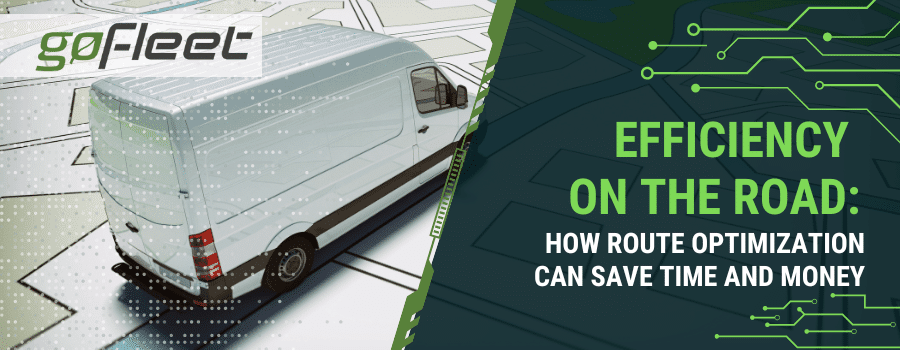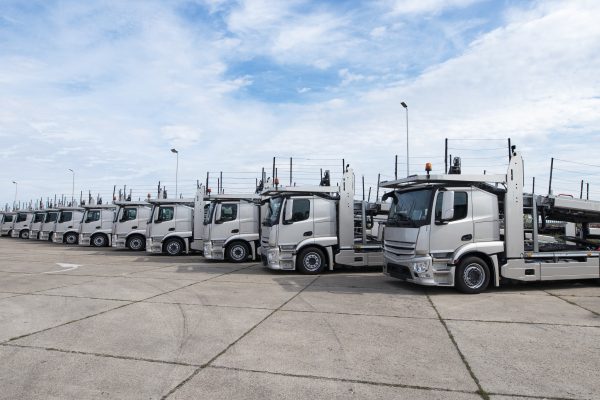In a world where time is often equated with money, the need for efficiency in every aspect of our lives, especially transportation, has never been more pressing. Route optimization emerges as a pivotal solution in this context, transforming the way we navigate our journeys.
At its core, route optimization is more than just finding the shortest path between two points. It involves a complex analysis of various factors such as traffic conditions, vehicle type, and delivery windows to determine the most efficient route possible.
The relevance of this technology is not just theoretical. Statistics show that transportation route optimization can enhance operational efficiency by 20-30% for trucking fleets. This significant improvement is not just in terms of time saved, but it also extends to other critical aspects like reducing fuel consumption, thereby lowering pollution and emissions, improving driver satisfaction, and ensuring more accurate estimated times of arrival (ETAs) for deliveries.
As our world grows increasingly fast-paced and environmentally conscious, the importance of optimizing routes becomes more apparent, offering a blend of time and cost savings while contributing to sustainability efforts.
This article explores the nuances of route optimization, shedding light on its benefits and exploring how it can be a game-changer in various industries. From reducing operational costs to mitigating environmental impact, the journey through this topic promises to be as enlightening as it is essential.
Understanding Route Optimization
Route optimization is a strategic process that goes beyond the simple notion of finding the shortest path between locations. It involves a comprehensive approach to planning the most efficient and cost-effective routes for vehicles to take, considering multiple factors and constraints.
Definition and Key Concepts
-
- Definition: At its essence, route optimization is the process of determining the most efficient route(s) for a set of destinations. This involves not just minimizing travel distance or time, but also accommodating various constraints such as delivery windows, vehicle capacity, driver hours, and customer preferences.
- Key Concepts:
-
- Multi-Stop Routing: Unlike traditional navigation that focuses on point-to-point directions, route optimization often involves multi-stop routes, where the order of stops is as crucial as the paths taken.
- Dynamic Routing: The ability to adjust routes in real-time based on changing conditions like traffic, weather, or last-minute schedule changes.
- Constraint-Based Planning: Considering factors like vehicle types and capacities, driver schedules, and specific customer requirements.
Algorithms and Technologies Involved
- Algorithms:
-
-
- Genetic Algorithms: Mimicking natural selection to continuously improve route efficiency over successive iterations.
- Simulated Annealing: Using probability to explore different route configurations and gradually honing in on the most efficient one.
- Greedy Algorithms: Quickly generating a route by making the locally optimal choice at each step, with adjustments for improved efficiency.
-
- Technologies:
-
- GPS and GIS: Utilizing Global Positioning Systems and Geographic Information Systems for accurate location tracking and mapping.
- Machine Learning: Analyzing historical data to predict traffic patterns and optimize future routing.
- Cloud Computing: Leveraging cloud-based platforms for scalable, real-time route optimization solutions that can handle large datasets and complex routing scenarios.
Together, these technologies and algorithms enable route optimization systems to offer sophisticated and flexible solutions that significantly boost efficiency and effectiveness in various transportation-related operations.
The Impact of Inefficient Routing
The consequences of inefficient routing can be far-reaching, impacting not only operational costs but also environmental sustainability and workforce morale.
The Cost of Inefficient Routes in Terms of Time and Money
- Operational Costs: Companies that rely on manual or basic tools for route planning can find their transportation operational costs inflated by 10-30% more than necessary. These avoidable costs extend beyond mere transportation expenses, affecting the overall financial health of the organization.
- Increased Mileage and Time: Inefficient routes typically result in the use of more miles and time than needed. Considering that the average cost of a truck mile is calculated at $1.82, reducing total annual fleet miles by even 10-15% can lead to substantial savings, highlighting the monetary losses incurred due to inefficient routing.
Real-World Examples of Inefficiencies in Routing
- Driver Turnover Costs: The dissatisfaction caused by inefficient routing can lead to driver turnover, which is costly. The average cost of hiring a new driver is around $8,200, including recruitment, administration, and training expenses. Fair and achievable route allocation, a benefit of efficient routing, plays a crucial role in driver satisfaction and retention.
- Environmental Impact: Beyond the direct financial implications, inefficient routing contributes to unnecessary fuel consumption and increased emissions, adversely affecting the environment.
- Customer Satisfaction: Inefficient routes often lead to delays and inconsistencies in service, impacting customer satisfaction and potentially harming the company’s reputation.
These examples underscore the significance of adopting advanced route optimization solutions. Not only do they offer financial benefits, but they also contribute to environmental sustainability and improved employee and customer satisfaction.
Benefits of Route Optimization
Route optimization stands as a cornerstone in modern operational strategies, offering a spectrum of benefits that transcend mere logistical improvements. By refining the way routes are planned and executed, this technology brings about significant time and cost savings, while also contributing to environmental sustainability.
Below, we’ll look at specific advantages that route optimization offers, which collectively enhance overall business efficiency and responsibility.
Time Savings: Reducing Travel Time
- Efficient Routing: Optimized routes minimize unnecessary detours and delays, directly reducing travel time. This efficiency is crucial for time-sensitive deliveries and services.
- Dynamic Adjustments: Real-time adjustments to routes in response to traffic, weather, or other unforeseen circumstances help maintain the shortest possible travel times.
Cost Savings: Reduction in Fuel Consumption and Maintenance Costs
- Fuel Efficiency: Less time on the road means lower fuel consumption, a significant cost factor for transportation and logistics companies.
- Vehicle Maintenance: Reduced wear and tear from fewer miles traveled leads to lower maintenance costs and extended vehicle lifespan.
Environmental Benefits: Lower Carbon Footprint
- Reduced Emissions: Fewer miles traveled and less time idling result in lower greenhouse gas emissions, contributing to a smaller carbon footprint.
- Sustainable Operations: Route optimization aligns with broader environmental goals by promoting more sustainable business practices.
Route Optimization in Different Industries
Route optimization is not confined to a single industry; its benefits span across various sectors, each with unique demands and challenges. By enhancing efficiency, reducing costs, and improving service quality, route optimization proves its versatility and critical role in different operational contexts. Let’s explore how this technology is applied across diverse industries.
Logistics and Delivery Services
- Efficiency in Delivery: Optimizes delivery schedules, ensuring timely deliveries while minimizing travel distances and times.
- Customer Satisfaction: Improves the accuracy of delivery windows, enhancing customer service.
Public Transportation Systems
- Optimized Scheduling: Enhances route planning for buses and trains, reducing wait times and improving passenger experience.
- Resource Allocation: Ensures efficient use of vehicles and personnel, increasing system reliability.
Emergency Services and Healthcare
- Rapid Response: Facilitates quicker response times for ambulances and emergency vehicles, potentially saving lives.
- Resource Management: Efficiently allocates resources such as ambulances and medical staff.
Field Service Management
- Scheduling Efficiency: Improves the planning of service visits, reducing travel time for technicians.
- Cost Reduction: Lowers operational costs through efficient route planning, directly impacting the bottom line.
In each of these sectors, route optimization plays a crucial role in enhancing efficiency, reducing
costs, and improving service quality, demonstrating its universal applicability and value.
Case Studies: The Transformative Power of Route Optimization
The implementation of route optimization has proven to be transformative for various businesses and organizations. These case studies showcase how different entities have harnessed the power of route optimization to achieve remarkable improvements in efficiency, cost savings, and customer service.
1. Fit Fixins: Meal Delivery Service
-
- Background: Fit Fixins, a meal delivery company in Florida, faced challenges in managing logistics efficiently.
- Implementation: They adopted route planning software to streamline their route planning.
- Benefits:
-
- Increased Delivery Capacity: Doubled meal delivery capacity, handling up to 35 deliveries per route within a 4-hour window, compared to 15-20 previously.
- Reduced Operating Costs: Saved over $3,000 annually in staff time, plus additional savings from reduced fuel consumption and vehicle maintenance.
- Improved Efficiency: Reduced route planning time from over 3 hours to 30 minutes to 1 hour, twice a week.
- Enhanced Customer Service: More timely deliveries and the ability to provide accurate ETAs to customers.
2. Food & Friends: Nonprofit Organization
-
- Background: Food & Friends, providing meals and groceries, needed efficient routing for their growing delivery needs.
- Implementation: Commissioned a software development company to integrate Route Optimization API into their operations.
- Benefits:
-
- Time Savings: Reduced manual route optimization time from 2 hours a day to saving 10 hours per week, amounting to 520 staff hours per year.
- Operational Efficiency: Streamlined food preparation and deliveries for thousands of people, including those with special dietary needs.
- Resource Optimization: Efficient use of 9 vans and numerous volunteer drivers for deliveries.
- Enhanced Donor Appeal: Demonstrated efficient operations as a compelling point for donors, stretching financial resources further.
3. White Picket Produce: Organic Produce Delivery
-
- Background: White Picket Produce, an organic produce delivery business in Florida, sought to reduce delivery costs.
- Implementation: Adopted routing software for delivery route planning.
- Benefits:
-
- Cost Savings: Annual savings of approximately $4,500, with the software paying for itself in the first month.
- Reduced Environmental Impact: Lessened miles driven, resulting in lower fuel costs and reduced carbon footprint.
- Time Efficiency: Saved approximately 2 hours per week in route planning.
These case studies demonstrate how diverse businesses and organizations can significantly benefit from implementing route optimization solutions, leading to improved efficiency, cost savings, and better customer service.
Final Thoughts
Route optimization stands out as a critical component in the contemporary business landscape, offering a multifaceted approach to improving operational efficiency. The compelling benefits highlighted in various case studies—ranging from substantial time and cost savings to enhanced environmental sustainability—underscore its significance.
To discover more about how route optimization can benefit your business, reach out to our knowledgeable GoFleet consultants today. They are ready to assist you in navigating this vital aspect of your business journey.



